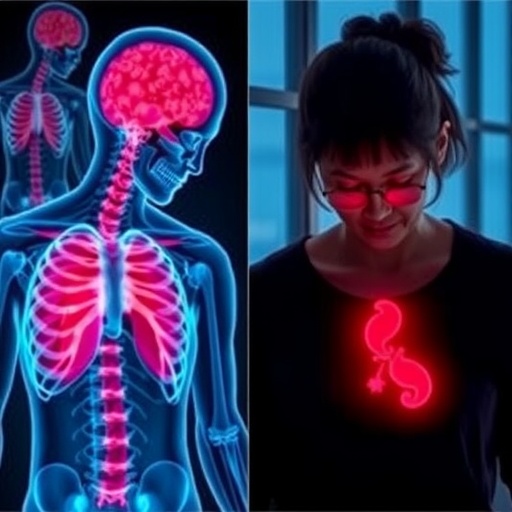In a groundbreaking study published in BMC Psychiatry, researchers have unveiled compelling evidence linking muscle deterioration types—sarcopenia and dynapenia—with depression rather than anxiety in Chinese patients undergoing hemodialysis. This discovery sheds new light on the complex biopsychosocial interactions experienced by individuals receiving maintenance hemodialysis and opens avenues for targeted interventions aimed at improving mental health outcomes in this vulnerable population.
Hemodialysis patients face a multifaceted health burden, with affective disorders such as depression and anxiety contributing to worse clinical outcomes and diminished quality of life. Despite the prevalence of these psychiatric conditions, the nuanced relationships between specific physical decline syndromes and emotional well-being have remained elusive. Sarcopenia, characterized by significant loss of muscle mass and function, and dynapenia, marked mainly by muscle strength reduction without pronounced mass loss, represent critical but distinct facets of muscular impairment.
The research team assembled a robust cohort of 1,074 patients from seven dialysis centers across Shanghai, China, spanning a three-year period from 2020 to 2023. The participants, predominantly male with an average age of 61.3 years, underwent comprehensive evaluations including muscle mass measurements, functional strength assessments, and mental health screenings. Depression was quantified using the widely validated Patient Health Questionnaire-9 (PHQ-9), while anxiety levels were gauged through the 7-item Generalized Anxiety Disorder Questionnaire (GAD-7).
Employing diagnostic thresholds established by the 2019 consensus from the Asia Working Group on Sarcopenia, patients were stratified into four categories: sarcopenia, dynapenia, presarcopenia (reduced muscle mass without strength loss), and a robust control group. Results illuminated a striking disparity in depression prevalence—with sarcopenia and dynapenia groups exhibiting rates of 19.4% and 22.8% respectively, compared to just 8.9% in the robust cohort. Contrastingly, anxiety rates did not demonstrate statistically significant differences across these stratifications, hovering below 11% in all groups.
Delving deeper, multivariate analyses highlighted sarcopenia and dynapenia as significant independent predictors of depression. Additional factors intertwined with depressive symptomatology included the Malnutrition-Inflammation Score (MIS), Charlson Comorbidity Index (CCI), and the fractional urea clearance index (Kt/V), underscoring the interrelation between physical health, nutritional status, and psychological well-being. These findings audibly stress the importance of considering muscle health as a pivotal component in the mental health management paradigm for hemodialysis patients.
The study’s revelations resonate deeply within clinical nephrology and psychiatric care disciplines, suggesting that efforts to mitigate muscle wasting and strength loss could be instrumental in alleviating depressive symptoms among this population. Traditional focus on dialysis adequacy and somatic complications might thus be complemented by integrated rehabilitative strategies targeting sarcopenia and dynapenia, potentially encompassing resistance training, nutritional optimization, and inflammatory modulation.
Moreover, the dissociation between depression and anxiety concerning muscle impairment propels intriguing hypotheses about the differential neuropsychological impact of physical decline. While depression appears tightly linked to muscle deficits, anxiety does not follow the same pattern, prompting future investigative pursuits to demystify underlying neurobiological pathways and psychosocial mediators that selectively connect muscular health with mood disorders.
This comprehensive research underscores the urgency of routine screening for sarcopenia and dynapenia in dialysis units, employing consensus-driven diagnostic tools to identify at-risk individuals accurately. Early recognition could foster timely multidisciplinary interventions, possibly stemming the progression of muscle loss and depressive symptoms, thereby improving adherence to treatment and overall patient outcomes.
The demographic magnitude and methodological rigor of the study lend robustness to its conclusions. However, the predominantly Chinese patient population suggests the prudence of replicative studies across varied ethnic and geographic cohorts to examine external validity and cultural determinants influencing these associations.
As the global hemodialysis population grows amidst aging trends and rising chronic kidney disease prevalence, this study’s insights offer a beacon toward holistic care paradigms. Health practitioners, policymakers, and researchers are thus equipped with vital evidence prompting integrated physical and mental health management protocols to uplift survival rates and life quality.
Ultimately, the elucidation that sarcopenia and dynapenia are entwined with depression but not anxiety in hemodialysis patients amplifies the narrative that physical health imperils mental wellness in specific and nuanced ways. Harnessing this knowledge promises to transform therapeutic approaches—emphasizing muscle preservation not only as a foundation for physical functionality but also as a crucial element for mental health resilience in life-sustaining dialysis care.
Subject of Research: The association between muscle deterioration (sarcopenia and dynapenia) and affective disorders (depression and anxiety) in Chinese hemodialysis patients.
Article Title: Sarcopenia and dynapenia are associated with depression rather than anxiety in Chinese hemodialysis patients.
Article References:
Chen, X., Han, P., Liang, Z. et al. Sarcopenia and dynapenia are associated with depression rather than anxiety in Chinese hemodialysis patients. BMC Psychiatry 25, 930 (2025). https://doi.org/10.1186/s12888-025-07365-3
Image Credits: AI Generated




